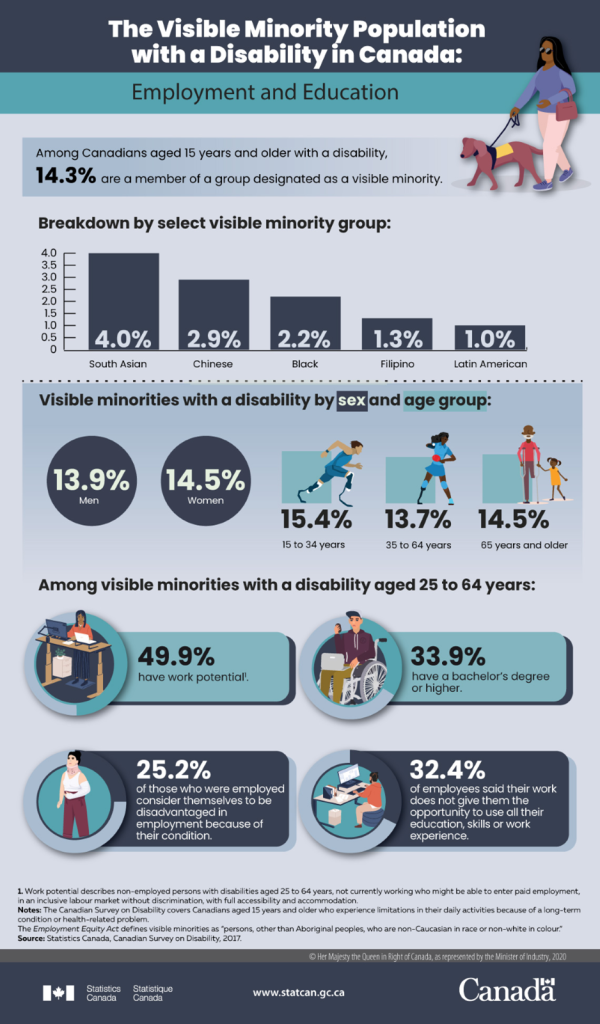Tool: Intersectionality of Race and Disability
This resource is to be used by instructors as an introduction to the intersectionality specifically of race and disability, and as a prompt to reflect on, and review, how intersectionality impacts student experiences with curriculum, pedagogy, and the classroom.
Reflective Pause
Reflect on your current experiences as it relates to this topic.
Consider what you are looking forward to learning more of, or hope to be able to do more of, as you work towards developing anti-racist practices.
Goals
- Learn how the intersection of ableism and racism lead to increased oppressive burden for racialized individuals with disabilities.
- Reflect on how the intersectionality of race and disability can affect student experience with pedagogy, the classroom, and curriculum.
How-to-Guide
What is intersectionality?
Intersectionality is a concept introduced in 1989 by Professor Kimberlé Crenshaw, an American civil rights advocate. It provides a framework for understanding how our multiple social identities intersect and interact with systems of racism and oppression (The Authors, 2020). To watch a brief video on the topic by Professor Kimberlé Crenshaw, click: What is Intersectionality? (YouTube).
Intersectionality brings together various aspects of our identity, such as race, socioeconomic class, gender, sexual orientation, age, ethnicity, religion, disability, and others, to form a more authentic and accurate sense of self. It should also be noted that this intersectionality is not only limited to what is visible or apparent, but it can often be intersections with invisible aspects (such as religion, sexual orientation, disability, etc.) too.
Intersectional theory contends that the disadvantages people face are a result of not just one, but multiple, interconnected sources of oppression. Each of their identity markers (e.g., “Muslim” and “female”) would not then exist independently of each other, but rather would inform one another, creating a complex convergence of oppression (YWBoston, 2017).
Intersectionality and Disability
Intersectionality is composed of our social identities, the systems of oppression in which we operate, and the ways in which they intersect. The oppression that racialized individuals with disabilities experience, therefore, is compounded through the intersection of racism and ableism. Ableism can be defined as: “[the] discrimination, prejudice or a systemic bias against individuals with disabilities. Ableism instils the idea that disabled people are less than people without disabilities.” (Loeppky, 2023).
The intersectionality of race and disability can also get more complex as we see disability being used as a driver or reason behind racial discrimination. The quote below by Isabella Kres-Nash, an American civil rights lawyer, helps us to understand this complexity further.
“Racism and ableism are often thought of as parallel systems of oppression that work separately to perpetuate social hierarchy. Not only does this way of looking at the world ignore the experiences of people of color[sic] with disabilities, but it also fails to examine how race is pathologized in order to create racism. Meaning that society treats people of color[sic] in specific ways to create barriers, and these poor conditions create disability. The concept of disability has been used to justify discrimination against other groups by attributing disability to them.”
To further explore intersectionality of race and disability, watch this linked video: Intersectionality & Disability, ft Keri Gray (2:11). Keri Gray, a Black disabled woman, shares a personal intersectionality example.
The following graphic demonstrates the incidence of the Canadian population who identifies as a “visible minority” as well as having a disability, and was produced by the Government of Canada (Statistics Canada, 2020):

For specific details on student diversity and intersectionality, please see KPU’s 2023 Student Satisfaction Survey Report: Student Diversity. Which can be found at the following link: Diversity Infographic_Nov 18_0.pdf
For questions about the survey and/or results, please contact the Office of Planning & Accountability
Racialized people with disabilities experience lower diagnosis rates of cognitive or mental disabilities, decreased access to medical and healthcare resources, increased poverty rates, and lower graduation rates, compared with white individuals with disabilities or with racialized individuals with no disabilities (Courtney-Long, 2017; U.S. Commission on Civil Rights, 2019; Ratto, 2016; Whiston, 2011).
Checklist
The checklist below will help you ensure your course contents are accessible to all your students including racialized students with disabilities. This list should work in conjunction with the list in the previous Tool: Anti-Racism Presentation Design. For example, not only images should be accessible, but they should represent different racial identities.
Accessibility Checklist
By observing the following standards and practices, instructors can start to ensure that students of all backgrounds and ethnicities experience equitable access to learning content and materials
Organizing content
- Content is organized under headings and subheadings.
- Headings and subheadings are used sequentially (e.g., Heading 1, Heading 2)
Images
- Images that convey information include alternative text (alt text) descriptions of the image’s content or function
- Graphs, charts, and maps also include contextual or supporting details in the text surrounding the image
- Images do not rely on colour to convey information
- Images that are purely decorative do not have alt text descriptions (descriptive text is unnecessary if the image doesn’t convey contextual content information)
Links
- The link text describes the destination of the link and does not use generic text such as “click here” or “read more”
- If a link will open or download a file (like a PDF or Excel file), a textual reference is included in the link information (e.g., [PDF])
- Links do not open in new windows or tabs
- If a link must open in a new window or tab, a textual reference is included in the link information (e.g., [NewTab])
- For citations and references, use descriptive links (i.e. the title of the resource is hyperlinked), and the full URL is not hyperlinked
Tables
- Tables are used to structure information and not for layout
- Tables have one row in which cells are tagged as column headers, and one column (beginning on the second row) in which the cells are tagged as row headers
- Row and column headers have the correct scope assigned
- Tables include a caption
- Tables avoid merged or split cells
- Tables have adequate cell padding to provide space buffering around the data in each cell
Multimedia
- All audio content includes a transcript. The transcript includes all speech content and relevant descriptions of non-speech audio and speaker names/headings where necessary
- Videos have captions of all speech content and relevant non-speech content that has been edited by a human for accuracy
- All videos with contextual visuals (graphs, charts, etc.) are described audibly in the video
Formulas
- Equations written in plain text use proper symbols (i.e., −, ×, ÷)
- For complex equations, one of the following is true:
- They were written using LaTeX and are rendered with MathJax (Pressbooks)
- They were written using Microsoft Word’s equation editor
- They are presented as images with alternative text descriptions
- Written equations are properly interpreted by text-to-speech tools
Font size
- Font size is 12 point or higher for body text in Word and PDF documents
- Font size is 9 point for footnotes or endnotes in Word and PDF documents
- Font size can be enlarged by 200 per cent in webbook or eBook formats without needing to scroll side to side
Adapted from:
Coolidge, A., Doner, S., Robertson, T., & Gray, J. (2018). Accessibility toolkit – 2nd edition. BCcampus. https://opentextbc.ca/accessibilitytoolkit
Reflective Action Point
Reflect on your learning as you approach the end of this tool.
- What changes to your practice do you hope to implement?
- How can this tool support your anti-racist practice?
Instructor Resources
Instructors may use the resources below to expand on their learning on the intersectionality of racism and ableism:
Article: KPU signs Scarborough Charter to fight structural racism – For more information on the Scarborough Charter, please view Scarborough Charter on anti-Black racism and Black inclusion
Pressbook: Introduction to Criminology, Chapter 4.6 Intersectionality
Website: KPU Accessibility Plan
Website: BC Accessibility Act
Website: Canadian Human Rights Commission, Anti-racism work
Article: Ontario Human Rights Commission, An introduction to the intersectional approach
Pressbook: OER: Accessibility Toolkit – 2nd Edition
Briefing Report U.S. Commission on Civil Rights: Beyond Suspensions: Examining School Discipline Policies and Connections to the School-to-Prison Pipeline for Students of Color with Disabilities
Website: 10 Principles of Disability Injustice
Article: Breaking the School-to-Prison Pipeline for Students with Disabilities, National Council on Disability
Article: Deconstructing Racism and Ableism in the School-to-Prison Pipeline, – Temple University Institute on Disabilities
Podcast: We Can’t Address Disability Without Addressing Race,
List of OERs on Inclusion, Diversity, Accessibility, Anti-racism, and Equity
Blog post: Designing for Disability Justice: On the need to take a variety of human bodies into account
Article: Anti-Black Racism and Ableism in the Workplace
Article: Disabled Asian Americans Deal With Racism and Ableism
Blog post: We can’t address disability without addressing race. Here’s why.
Blog post: To Be BIPOC, Disabled and Fighting for Justice
Research paper: Disability Inequity: The Urgent Need for Race-Conscious Resource Remedies
Video: Aimi Hamraie on “Making Access Critical: Disability, Race, and Gender in Environmental Design”
Website: National Black Disability Coalition
Website: Workplace Strategies for Mental Health, – this website provides further information and resources about Intersectionality, as well as connections to other areas such as implicit bias and microaggressions.
Guidance: Sheridan College’s Inclusive Language Guide “Tip Sheet” on persons with disabilities, provides a wealth of guidance and information on appropriate and inclusive language and terminology related to disabilities.
Guidance: Sheridan College’s Inclusive Language Guide “Tip Sheet” on race and ethnicity, provides a wealth of guidance and information on appropriate and inclusive language and terminology related to race and ethnicity.
References
- Coolidge, A., Doner, S., Robertson, T., & Gray, J. (2018). Accessibility toolkit – 2nd edition. BCcampus. https://opentextbc.ca/accessibilitytoolkit
- Courtney-Long, E.A., Romano, S.D., Carroll, D.D. et al. (2017). Socioeconomic factors at the intersection of race and ethnicity influencing health risks for people with disabilities. Journal of Racial and Ethnic Health Disparities, 4(213). DOI: 10.1007/s40615-016-0220-5
- Loeppky, J. (2023). Ableism in Canada. In The Canadian Encyclopedia. Retrieved from https://www.thecanadianencyclopedia.ca/en/article/ableism
- Ratto, A. B., Anthony, B. J., Kenworthy, L., Armour, A. C., Dudley, K., & Anthony, L. G. (2016). Are non-intellectually disabled Black youth with ASD less impaired on parent report than their White peers?. Journal of autism and developmental disorders, 46(3), 773–781. https://doi.org/10.1007/s10803-015-2614-3
- Statistics Canada. (2017). The visible minority population with a disability in Canada: Employment and education. Statistics Canada, Canadian Survey on Disability. Retrieved from https://www150.statcan.gc.ca/n1/pub/11-627-m/11-627-m2020086-eng.htm
- The Authors. (2020, August 1). Kimberlé Crenshaw’s Intersectional Feminism. Daily JSTOR. https://daily.jstor.org/kimberle-crenshaws-intersectional-feminism/
- U.S. Commission on Civil Rights. (2019). Beyond suspensions: Examining school discipline policies and connections to the school-to-prison pipeline for students of color with disabilities. Briefing Report. https://www.usccr.gov/files/pubs/2019/07-23-Beyond-Suspensions.pdf
- Whitson, H. E., Hastings, S. N., Landerman, L. R., Fillenbaum, G. G., Cohen, H. J., & Johnson, K. S. (2011). Black-White disparity in disability: The role of medical conditions. Journal of the American Geriatrics Society, 59(5), 844–850. https://doi.org/10.1111/j.1532-5415.2011.03401.x
Author Information
Written By: Rotem Lavy (Educational Developer, at NorQuest College)
Reviewed and Edited By: Reva George (Instructor, Business at NorQuest College)
Adapted for the KPU context by: Daniel Benzimra (Education Strategist, Teaching & Learning Commons) and Dr. Nishan Perera (Director Learning Technologies & Ed Development,
OEIC Reviewed by: Dr. Asma Sayed (Vice President, Equity and Inclusive Communities, Office of Equity & Inclusive Communities)

